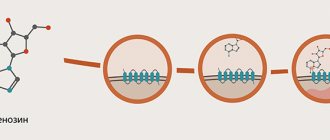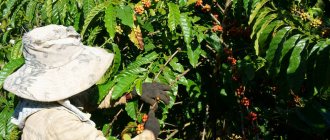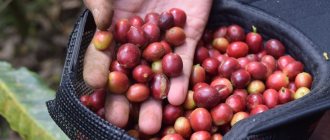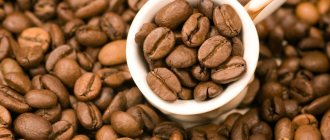Once upon a time, the inhabitants of Yemen took the coffee tree of the Typica variety from Africa and began to grow it. Under the influence of a different climate and soil composition, the plant gradually changed, undergoing mutations. In the course of natural crossing and selective selection, new varieties appeared. Arabian coffee began to be called Arabica, it became the most popular in the world. In the article I will talk about existing varieties of grains, the beneficial properties and possible harm of each type, features and effects on health.
Landing
The coffee bean is the seed for planting the coffee tree. Dried, roasted and ground, it is used to brew coffee. Unprocessed grain can be used for planting.
Coffee beans are planted in large tanks and left in dark rooms. The sprouts are watered regularly and kept away from sunlight. When they become strong enough, they are transplanted to plantations. This is usually done during the rainy season so that there is enough moisture in the soil to support the roots.
Content of proteins, fats and carbohydrates
Coffee beans, in addition to a huge number of active substances and aromatic compounds, contain three main groups of components:
- squirrels
- fats
- carbohydrates
Their ratio depends on the type of coffee, the method of preparation and the growing conditions of the plant.
Squirrels
The content of protein compounds strongly depends on the species of a particular coffee crop. The dependence of the concentration of alkaloids on the number of proteins was revealed. During storage, their quantity does not change in any way, but a tendency towards an increase in the water-soluble fraction is noticed.
In addition to proteins, the group of nitrogenous compounds includes more than 20 free-type amino acids. Their quantity does not change in any way during storage. High-grade coffee contains a predominant amount of them in its composition.
Fats
In coffee beans, the concentration of oily compounds depends on the species. The minimum amount of fat is found in coffee grown in India. Coffee oil has the peculiarity of a large number of esters. Saturated fatty acids in the oil make up more than half. The content of linoleic acid predominates.
The qualitative composition of the oily component is identical for all coffee crops. With increasing storage time, a tendency to slow down oxidative processes has been observed.
Carbohydrates
Complex and simple sugars in coffee beans have a strong influence on the taste of the finished drink. They can serve as precursors for the formation of volatile structures obtained during roasting. These compounds give the drink a special aroma.
Carbohydrates in coffee are found in the form of glucose, fructose, galactose and sucrose, the concentration of which is about 30% of the water-soluble fraction. Each type of coffee contains a certain amount of sugars. During storage, their concentration does not change much.
The composition of coffee beans includes fiber, which occupies almost a third of the volume; it gives density to the grain. This property does not allow the raw material to be severely destroyed or boiled, increasing in volume. Fiber helps preserve the aromatic compounds that give the drink its special smell. This compound is quite stable; different types of coffee plants do not differ in its content.
Harvesting
It will take three to four years for the tree to begin bearing fruit. Unripe coffee berries are green in color. Depending on the variety, they turn bright or dark red when ripe and ready for harvest. They ripen faster in low mountainous areas and at high temperatures. Usually the crop is harvested once a year. In countries where flowering occurs twice a year, such as Colombia and Kenya, coffee is harvested twice a year.
Coffees harvested early or late in the season have a weak flavor, while mid-season coffees harvest bold flavor profiles. For this reason, the best roasters purchase their coffee mid-season.
In most countries, manual labor is used to ensure the ripeness of the berries. The fruits ripen at different times and it may take up to three pickings to fully harvest the entire crop. In countries with relatively flat landscapes, such as Brazil, this process takes place using machinery, which certainly makes the job easier.
Harvesting is done in one of two ways:
- Stripping - all the berries are removed from the branch at the same time by hand or using equipment.
- Picking - only ripe berries are removed and only by hand. Farmers walk around the trees every 8-10 days, choosing only the ripest berries. Due to the fact that this method is labor-intensive and more expensive than stripping, it is used primarily for collecting high-quality Arabica beans.
A good harvester will collect 45-90 kilograms of coffee cherries per day, which can then be used to produce only 10-20 kilograms of coffee! The number of berries collected by each picker per day is weighed, and labor is paid based on the results.
Treatment
After harvesting, processing must begin as soon as possible to prevent spoilage of the berries. Depending on the country and local resources, coffee is most often processed in one of two ways:
- Drying is an ancient method of coffee processing, often used in countries with limited water resources. Freshly picked berries are placed in the sun. To prevent the berries from spoiling, they are turned over several times during the day, and covered at night and during rain to prevent them from getting wet. This process can continue for several weeks until the water content in the berries is reduced to 11%.
- Washed - begins with removing the pulp from the grain, so it is simply dried in its own shell, the so-called “parchment”. First, the freshly picked berries are sent for processing in special equipment, where the pulp is removed. Next, the grains are grouped by weight, passing through water streams. Light grains go up, and heavy grains go down. So, the grains pass through several of these sorting drums with water, where they are separated by size. After sorting, the grains are placed in large tanks of water. Various factors—bean quality, climate, and altitude—affect how long the grains remain in these tanks. As a rule, they remain there for 12-48 hours, after which the grains pass through water streams again and are sent for drying.
In fact, these are not all processing methods, but only the main ones. You can learn more about all types of processing from our separate article on this topic.
Caffeine
Caffeine is the main active ingredient in coffee. Thanks to its effects, our body is charged with vigor, vascular tone increases, and the functioning of the brain, gastrointestinal tract and other systems improves. It is not for nothing that caffeine was included in the list of medicinal substances. It has long been used in some medicines. The most famous of them is Citramon.
Caffeine is the most important alkaloid found in coffee beans. It has no color or smell. In aqueous solution it has a bitter taste. Different types of coffee contain different amounts of caffeine. The quality characteristics of the raw material directly depend on its concentration. The more it is, the more coffee beans are valued.
Why does caffeine affect our body so much? It is an alkaloid that can stimulate the central nervous system. It is this ability that ensures such a violent reaction of the human body to drinks with a high caffeine content. It is interesting that caffeine was first obtained from coffee beans. That is why this substance was called caffeine. It is this powerful alkaloid that provides the tonic effect of coffee. However, this drink not only tones, but also increases performance, physical and mental. To ensure this energizing effect, coffee producers strictly monitor the caffeine levels in the beans they use. The norm is no less than 0.7%. It is this alkaloid content that ensures the sustained tonic effect of coffee.
What determines the final level of caffeine content in coffee beans? First of all, the degree of ripening of the grains plays a role. The better they ripen, the more caffeine they accumulate. Roasting the beans also plays an important role. The more they are roasted, the greater the caffeine concentration. If the recommended concentration is maintained, then a teaspoon of ground coffee contains about 0.1 - 0.2 g. caffeine in its pure form. This amount will be quite enough to get a pronounced tonic effect. But doctors do not recommend increasing this dose. Otherwise, you may get a negative response from the body to an overdose of caffeine. The maximum dose you can afford is a concentration of 0.3 g. caffeine in one go. After this, you should completely abstain from drinking coffee for 3-4 hours.
What happens if a person exceeds the dose of caffeine? Regularly exceeding the dose of caffeine recommended by doctors can lead to the following negative consequences:
- the work of the heart will increase;
- excitability will increase;
- sleep may be disturbed, etc.
Drying
If the beans have been processed using the washed type of processing, they must be dried until the moisture content does not exceed the same 11%. These grains are still covered with parchment. Drying is carried out either on large tables, where they are regularly turned over, or using equipment.
All the dried beans, called unhulled coffee beans, are taken to a warehouse in jute or sisal bags where they will await their turn for export.
Sorting coffee beans
Grade 1: Special grade coffee beans: no primary defects, 0–3 total defects, graded to a maximum size of 5% above and 5% below a specific screen size or range of screen sizes, and exhibit a distinctive attribute in one or more of the following: flavor , acidity, body or aroma. There should also be no defects or damage to the cup. There should be no Quakers. Moisture content between 9-13%.
2nd grade: premium coffee beans: the same characteristics as 1st grade, with the exception of a maximum of 3 quakers. 0-8 total defects.
3rd grade: exchange coffee beans: 50% above sieve number 15 and less than 5% below sieve number 15. Maximum of 5 quakers. There should be no mistakes. 9-23 total defects.
Grade 4: Standard grades of coffee beans: 24-86 total defects.
Grade 5: low-quality coffee beans: more than 86 complete defects.
Cleaning
Before sending grains for export, producers carry out final processing of the grains. It takes place in three stages:
- Removing parchment. The parchment is removed from washed grains, since everything else was removed during the processing stage. Dry processed grains are cleared of all dried pulp.
- Polishing. An optional process by which all remaining fine particles are removed from the grain. While polished grains are considered better than unpolished grains, in reality there is little difference between the two.
- Grading and sorting. Occurs based on size and weight. Grains are also graded for the presence of imperfections in color. To determine the size of the grains, they are passed through several measuring instruments. They are also sorted in special equipment with high pressure to separate heavy grains from light ones. Defective grains are selected manually or automatically. Those that do not meet quality criteria (unacceptable size or color, presence of insects inside, excessive fermentation) are discarded. In many countries, both manual labor and equipment are used for this sorting to ensure high quality grains.
Cupping
Cupping - quality and taste testing - is carried out several times in a room specially equipped for this.
First, the cupper evaluates the grains by appearance. Then the grains are roasted in a small laboratory roaster, immediately ground and poured with hot water at a strictly regulated temperature. The first thing a cupper begins to evaluate a drink with is the aroma.
Next, the cupper tastes the coffee in small portions, while trying to cover all taste buds.
Coffee is analyzed not only to determine characteristics and shortcomings, but also to create balanced blends and select the desired type of roast. Experienced cuppers can taste hundreds of different varieties a day and still feel the subtle differences between them.
Roasting
Roasting turns green beans into the aromatic chocolate-colored beans that we are used to seeing in stores and coffee shops. Most roasters roast coffee at around 287°C. All this time, the roaster blades constantly mix the grains so that they do not ignite.
When the internal temperature of the beans reaches approximately 205°C, they turn brown and secrete kafeol, an oil contained in the beans themselves. The process is called "pyrolysis"; This is a kind of “heart” of roasting - it reveals the aroma and taste of the coffee we drink.
After roasting, the beans are immediately cooled with air or water. Roasting is usually performed by the importing country because freshly roasted beans need to reach consumers as quickly as possible.
There are 3 basic coffee roasts: light, medium and dark. Light and medium roasts best retain the true flavor of the beans, while dark roasts are bitter and contain the least caffeine.
How to cook in a Turk
To brew delicious black coffee in a Turk on the stove and not only, you need to follow some rules and nuances and then you will fully enjoy this noble drink. Let's look at the stages of brewing coffee at home point by point.
- Heat the empty Turk a little over low heat.
- Pour ground coffee into the bottom and warm it up a little.
- Pour water up to the narrow neck
- Cook over medium or slightly lower heat until foam appears
- Pour into cups
These are the main points of cooking in a cezve (aka Turk). But in order for the coffee to be tasty and aromatic, you need to know the following nuances:
- A pinch of salt at the bottom of the Turkish coffee before cooking will make the taste softer and you should not be afraid that the coffee will be salty. You can also add a little sugar, cinnamon or anise at this stage.
- A good proportion of ground coffee is 1 teaspoon per 100 ml of water.
- If the coffee is in beans, it is better to grind it before brewing, since ground coffee quickly loses its taste and aroma.
- Water must be purified or bottled.
- Do not let it boil, as the foam will be destroyed, and this is perhaps the most delicious part of the drink.
- To help the coffee settle to the bottom faster after brewing, you can lightly tap it on the edge of the table.
- A preheated cup will retain the aroma longer.
Preparation
The preparation method affects the taste of the coffee in the cup, so at True Coffee we always list recommended preparation methods for our varieties. What types of brewing are there?
- Pressure brewing (espresso machine, moka, aeropress)
- Soaking (French press, siphon)
- Filter coffee or drip method (Chemex, Hario, Cold Brew)
You can learn more about brewing coffee in our article on coffee drinks and in our brewing guide.
When we started writing this article, we never thought that we would discover so many nuances that need to be described and that we take for granted. This helped us analyze the coffee journey from start to finish and establish a clearer picture of the industry as a whole. We hope that the article was also useful to you and that you learned something new and interesting.
Vitamins and microelements
Coffee made from beans of natural origin contains a large amount of vitamins and microelements. Vitamins in coffee are widely represented. They play an important role in human physiology. What vitamins are present in the drink:
- Niacin is a substance that regulates oxidation processes in cells. Helps normalize blood cholesterol levels and participates in the processes of synthesis of energy reserves. has a significant effect on the metabolism of amino acids in the body.
- Thiamine is a vitamin that affects the metabolism of carbohydrates and proteins. It affects the functioning of almost all organs.
- Vitamin B2 is a substance that helps accelerate metabolic processes. Promotes the binding of oxygen by cells.
- The remaining vitamins are presented in smaller quantities and are not able to influence the physiology of the body.
In addition to vitamins, the drink contains a sufficient amount of microelements. These are the following substances:
- calcium—affects connective tissue cells, ensuring their health and the normal course of physiological processes;
- magnesium - normalizes the functioning of cardiomycytes, restores heart rhythm. Also necessary in the formation of the bone skeleton and normalization of blood sugar levels;
- sodium - ensures the proper functioning of intercellular structures, normalizes the speed of impulses. This element has a beneficial effect on heart function and muscle contraction;
- Phosphorus is a necessary element that restores proper metabolism. Promotes regeneration of damage in the body;
- iron is an important trace element that is directly related to the amount of hemoglobin in the blood. It affects the normal course of all processes in the body.
Natural coffee, grown in environmentally friendly conditions, is not capable of having a harmful effect on the body. It does not contain harmful substances and oxidation products. But you must always adhere to the norm when drinking this drink.
Try our coffee
Mix of grains
Espresso coffee
Blend of 100% Arabica beans. The aroma reveals notes of roasted peanuts and hazelnuts, while the taste is dominated by dark chocolate and walnuts. Soft aftertaste of cocoa and burnt sugar.
Peru
Coffee "Chanchamayo"
Rich and strong coffee with notes of bread in the aroma.
Brazil
Coffee "Santos"
The aroma is dominated by spices and cocoa. The soft nutty-chocolate taste is offset by a slight sourness at the end.











